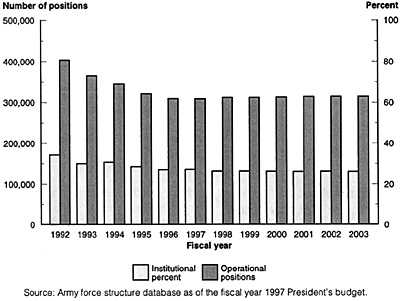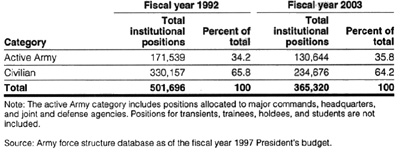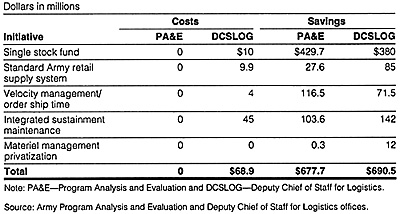Institutional Redesign Has Not Lived Up to Its Potential for Re-engineering the Institutional Force
Force XXI Institutional Redesign is the Army's effort to re-engineer its processes and streamline its organizational structure. It includes consolidating major commands; and realigning their missions to more efficiently perform institutional functions.
The Army defines re-engineering as a "...fundamental rethinking and radical redesign of business processes to achieve dramatic improvements in critical, contemporary measures of performance." The Army Vice Chief of Staff is responsible for re-engineering Army processes and organizations. The Deputy Chief of Staff for Operations and Plans is the executive agent for redesign assessments and is responsible for performing day-to-day support functions. Other Army headquarters offices are responsible for conducting the assessments and implementing approved initiatives.
Even though redesign efforts began in January 1995, there has been no net decrease in the number of major commands, and two of the redesign studies have been canceled. Also, the dollar and personnel savings estimates are overstated. The Army reported that redesign's phase I initiatives would save $1.7 billion over 6 years and that implementation would cost almost $27 million. The savings estimates are overstated because they do not include significant implementation costs of at least $405 million. Also, most of the 4,000 active Army positions that were to be transferred from institutional to operational forces were based on assumptions that may not occur. In addition, since no single office monitors the results of institutional redesign efforts, the Army has no systematic way of knowing the status of savings, implementation costs, or institutional position transfers.
The Army's redesign document, draft Pamphlet 100xx, [10]
states that it is intended to provide a vision for redesigning the institutional force and
serve as the foundation for institutional doctrine. The pamphlet states general goals of
improving institutional force efficiencies but, other than proposing models for reducing
the number of major command headquarters, does not cite specific, measurable
performance goals. However, the Government Performance and Results Act requires
federal agencies to identify strategic goals and develop performance measures to gauge
progress toward achieving each goal. The pamphlet is consistent with this principle,
stating that "clear performance measures should be identified to gauge organizational
progress."
The Army's institutional redesign effort has not reduced the number of major
commands, even though redesign documents state that the Army will strive to do so. The
redesign pamphlet introduces organizational models that would reduce the Army's current
15-major command structure to 8 or 3 major commands. For example, the three-command
structure would manage the Army's core capabilities of developing the force, generating
and projecting the force, and sustaining the force.
Army headquarters would retain responsibility for directing and resourcing
capabilities. During redesign phase 1, the Army redesignated a major command--the
Information Systems Command--as a subcommand of Forces Command. The Army also
created a new major command--the Space and Missile Defense Command. Thus, there has
been no net decrease in the number of major commands.
Some redesign transfer of functions from Army headquarters to major commands have
not yet resulted in significant efficiencies. For example, the Recruiting Command
transferred intact from Army headquarters to the Training and Doctrine Command in
October 1997 as a major subordinate command. However, there has only been a decrease of less than one-half of 1 percent in
the Recruiting Command's institutional positions. According to Army data, the
Recruiting Command had 9,256 positions in fiscal year 1997, and the Army projects 9,210
positions in fiscal year 1998.
The Army plans to merge the Recruiting Command with the Training and Doctrine
Command's Cadet Command in October 1999, a move that the Army expects will result in
organizational efficiencies and fewer institutional positions. The Army plans to conduct
a business process re-engineering study to determine the most effective and efficient
organization which is expected to result in fewer organizational layers.
The Army initially planned to examine the following seven areas during phase II of the
redesign effort: installation management; unit, joint, and interservice training; security and
law enforcement; financial management; medical and health; intelligence; and supply,
services, and materiel. However, officials from the Deputy Chief of Staff for Operations and
Plans told us that the financial management and supply, services, and materiel
assessments have been canceled.
According to these officials, the Financial Management and Comptroller's office has
chosen to use internal efforts to identify financial management efficiencies, rather than
complete an institutional redesign assessment, because the Assistant Secretary of the
Army for Financial Management and Comptroller reports to the Secretary of the Army and
not the Army Vice Chief of Staff. Further, the officials said that the Army Materiel
Command will not complete the supply, services, and materiel assessment because the
Command was responding to the mandated Quadrennial Defense Review reductions.
Pamphlet 100xx encourages outsourcing institutional functions. A recent Defense
Science Board study and the Quadrennial Defense Review also concluded that some
institutional functions should be contracted. If the Army reduced its reliance on active
military institutional personnel, more military personnel would be available for operational
units, including deployable support units, which have historically experienced shortfalls.
[11]
Although the number of Army institutional positions has decreased since 1992, Army
data show that the proportion of active Army institutional to operational forces has
remained at about 29 percent and is projected to remain at this level through fiscal year
2003, as shown in figure 3.
In addition, the proportion of all active Army institutional positions to the total
number of institutional positions is projected to increase slightly, from 34.2 percent in
1992 to 35.8 percent in 2003.
Table 1 compares the number of military and civilian institutional positions in fiscal years 1992 and 2003.
Phase I savings estimates are overstated because significant costs are not included
in the Army's 1998-2003 Program Objective Memorandum and savings estimates are not
definitive. Specifically, the memorandum included savings of $1.7 billion and almost $27
million in implementation costs resulting from 107 institutional redesign initiatives.
[12]
However, at least $405 million in implementation costs were not included in the memorandum.
The Army Program Analysis and Evaluation Office is to develop the service's Program
Objective Memorandum. According to an official from this office, limited cost data were
included in the memorandum because the offices responsible for the initiatives did not
provide cost data in a timely manner. For example, the Army Program Analysis and
Evaluation Office did not include $69 million in implementation costs for five logistics
initiatives.
In addition, the Army Program Analysis and Evaluation Office did not include
implementation costs for the Senior Reserve Officer's Training Corps initiative. This
initiative proposed replacing the Senior Reserve Officer's Training Corps active duty
institutional personnel with a combination of active, reserve, or contracted former military
personnel. The Reserve Officer's Training Corps program is in place at 300 colleges and
enables students to graduate with a degree and receive an officer's commission.
In February 1996, the Deputy Chief of Staff for Operations and Plans initially
estimated that the Senior Reserve Officer Training Corps initiative would cost
$336 "Rion over a 4-year period for contracting retired personnel to replace all
2,100 active Army personnel in the corps. However, the Army's Program
Objective Memorandum did not include any of the implementation costs
associated with the hiring of contractor personnel to conduct the Senior Reserve
Officer's Training Corps program.
The Army's memorandum only included implementation cost of $2 million for
RAND to study the concept of hiring contractor personnel. Once implemented,
the initiative is expected to require a recurring operations and maintenance cost of
$40,000 per contractor per year. [13]
For example, if all 2,100 active Army personnel were replaced by contractors-
in general, retired officers--the Army would incur a cost of $84 million per year.
Additionally, the $1.7 billion savings estimate is not definitive because two
offices disagree on the savings anticipated. The Deputy Chief of Staff for
Logistics is responsible for five logistics initiatives, which represent 40 percent of
the $1.7 billion phase I savings. The Army Program Analysis and Evaluation
Office and the Office of the Deputy Chief of Staff for Logistics identified savings
that varied from $12 million to $57 million per initiative, as shown in table 2, even
though the net difference amounted to approximately $13 million.
According to the Army Program Analysis and Evaluation Office, the savings
are also included in the 1998-2003 Future Years Defense Program, but specific
initiatives and groupings (such as logistics-related initiatives) cannot be tracked
because they are combined with other Army efforts.
According to the Principal Deputy Assistant Secretary of the Army for
Financial Management and Comptroller, the burden is on the major command to
identify a "substitute bill payer" if redesign savings cannot be achieved, since the
savings have already been included in the fiscal year 1998-2003 Program
Objective Memorandum. Officials from the Army Program Analysis and
Evaluation and Deputy Chief of Staff for Operations and Plans offices concurred.
For example, the fiscal year 1998-2003 memorandum claimed savings of
approximately $430 million for the single stock fund initiative. This effort is based
on the belief that a single stock fund eliminates duplicative materiel and financial
management functions. However, the Army Materiel Command, as the proponent
for this initiative, claims that fiscal year 1998 projected savings of $30 million will
not be realized because of problems in implementing changes to financial systems.
The Principal Deputy Assistant Secretary for Financial Management and
Comptroller told us that $30 million in savings will be realized in fiscal year 1998--
either from this initiative or elsewhere.
Phase I projected that 3,914 active Army positions could be transferred from
institutional to operational forces, but most of these transfers were based on
assumptions that may not occur. Our February 1997 report stated that many of the
active Army space transfers were based on initiatives that have not been fully
tested or approved; therefore, the savings were not assured. As a result, we
recommended that the Secretary of the Army closely monitor the military positions
the Army planned to save from the redesign initiatives and have a contingency plan in place in the event the personnel savings do not materialize. DOD concurred with this recommendation.
Officials from the Deputy Chief of Staff for Operations and Plans stated that the 3,914
spaces were transferred from institutional to operational forces, but most of the spaces did
not come from the phase I redesign initiatives. Two initiatives, which account for 2,850, or
73 percent, of the 3,914 active Army spaces, will not produce the projected number of
spaces.
For example, the Senior Reserve Officer's Training Corps initiative was expected to
transfer 2,100 positions. However, RAND currently estimates the initiative will yield
between 800 and 1,050 spaces because the Army decided not to contract out all 2,100
spaces and is testing a combination of active, reserve, and contract personnel.
Additionally, the transfer of positions is also based on reducing attrition. [14]
The Army assumed reduced attrition would free 750 training and recruiting
institutional positions. If personnel stay in the Army, then it would not need to recruit
and train replacements. However, the Training and Doctrine Command currently projects
an increase in initial entry training requirements from fiscal years 1998 to 1999 rather than
a decrease. Army headquarters officials acknowledged that they could not explain how
the 750 spaces were calculated, and Command officials said that it was not involved in
deriving the 750 spaces.
Even though the Deputy Chief of Staff for Operations and Plans is the executive agent
for redesign assessments, there is no single office that systematically manages and
monitors redesign results. Therefore, at any given time, the Office of Operations and Plans
does not know the status of specific initiatives, dollar savings, implementation costs, or
progress in reducing institutional positions. In addition, any differences in projected costs
and savings have not been reconciled between the Army Program Analysis and
Evaluation and the Army offices responsible for specific initiatives.
The Assistant Secretary of the Army for Financial Management and Comptroller is
responsible for quarterly Army performance reviews. These reviews are for the Secretary
of the Army, Army Chief of Staff, and function chiefs to discuss problem areas. However,
the Office of the Assistant Secretary states that institutional redesign initiatives are
monitored and discussed only if their implementation or savings become
jeopardized. A Financial Management and Comptroller written statement
explains that none of the redesign initiatives have been designated as topics to be
monitored during the quarterly reviews, including the Senior Reserve Officer's
Training Corps, which accounts for one-half the projected position transfers and
$336 million in unaccounted for implementation costs. A Financial Management
and Comptroller official told us that some quarterly reviews were canceled and
never rescheduled and that monitoring institutional redesign results would require
an investment of too many resources.
Pamphlet 100xx discusses the need to achieve efficiencies in performing
institutional functions. For example, the pamphlet states that it is necessary to
demonstrate that cost savings and/or operational efficiencies will result from
implementing redesign initiatives. However, beyond this overarching guidance, the
Array has not set specific, measurable, performance goals and assessed the
Army's progress in achieving them (e.g., program outcome evaluations).
More recently, DOD guidance to the military services for implementing the
Government Performance and Results Act states that the services should identify
performance measures that demonstrate how the services' plans, such as Army
Force XXI, achieve the goals of DOD's strategic plan.
Footnotes
[10] Pamphlet 100xx has been in draft since June 1995 and, according to Army officials, has been undergoing final editing since April 1997.
[11] Force Structure: Army Support Forces Can Meet Two-Conflict Strategy With Some Risks (GAONSUD-97-66, Feb. 28, 1997) and Peace Operations: Heavy Use of Key Capabilities May
Affect Response to Regional Conflicts (GAO/NSUD-95-51, Mar. 8, 1995).
[12] Phase I produced a total of 144 initiatives. The remaining 37 initiatives are expected to be implemented later. The initiatives submitted to the Vice Chief of Staff for approval contained estimates of dollar and position savings, both civilian and military. Army officials noted that the initiatives may also result in increased effectiveness. However, the officials did not provide any measures of performance for increased effectiveness.
[13] Since the contractors are retired officers, this cost represents the difference between the contractor's active duty and retirement salary.
[14] Attrition is defined as a soldier leaving the Army before his or her term of enlistment expires.
Redesign Effort Has Not Resulted in Major Organizational Changes or Efficiencies
 Figure 3: Active Army Institutional Positions as a Percent of Operational Forces
Figure 3: Active Army Institutional Positions as a Percent of Operational Forces
Source: Army force structure database as of the fiscal year 1997 President's budget.
 Table 1: Number of Active Army and Civilian Institutional Positions in Fiscal Years 1992 and 2003
Table 1: Number of Active Army and Civilian Institutional Positions in Fiscal Years 1992 and 2003
Dollar and Position Savings Are Not Occurring as Expected
 Table 2: Differences in Phase I Implementation Cost and Savings Data Between Army Program Analysis and Evaluation and Deputy Chief of Staff for Logistics Offices
Table 2: Differences in Phase I Implementation Cost and Savings Data Between Army Program Analysis and Evaluation and Deputy Chief of Staff for Logistics Offices
Source: Army Program Analysis and Evaluation and Deputy Chief of Staff for Logistics offices.
No Office Monitors the Results of Redesign Efforts
Redesign Lacks Specific Performance Goals
Back to Table of Contents Force Structure US Army
Back to GAO List of Issues
Back to MagWeb Magazine List
© Copyright 1998 by US GAO.
This article appears in MagWeb.com (Magazine Web) on the Internet World Wide Web.
Other articles from military history and related magazines are available at http://www.magweb.com